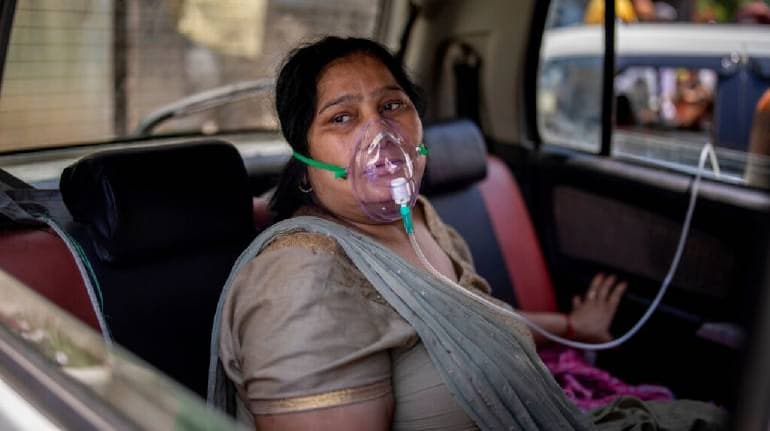



The government had gone on a mission mode to set up oxygen plants in hospitals after a severe shortage of the life-saving gas was blamed for a large number of deaths during the COVID-19 pandemic last year.
However, a report now says all notifications and regulations that necessitate new Pressure Swing Absorption (PSA) oxygen plants for medical colleges or hospitals should be withdrawn and instead a national oxygen grid set up.
The report titled 'Blueprint for the National Medical Oxygen Grid' by research organisation One Health Trust assessed the current mechanisms for the availability of medical oxygen in India and suggested ways to improve it.
The report, which has former National Health Authority executive director Indu Bhushan as one of the authors, has been supported by the US AID for International Development and Bill and Melinda Gates Foundation.
A total of 4,135 PSA plants have been established doubling the oxygen production capacity in the country since the devastating second wave of Covid-19, which killed lakhs of people across India, mainly due to oxygen shortage. Last year, the Centre made it mandatory for all new medical colleges to install a PSA plant within six months of getting operational.
Outlining the contours of the oxygen network, Ramanan Laxminarayanan, founder and president of One Health Trust, said it would be like an electricity grid, with central generation (liquid medical oxygen), transmission (tankers and cylinders), storage (liquid and gaseous) and decentralised production (pressure swing adsorption generators and oxygen concentrators).
No electricity grid would rely on just decentralised solar or micro-hydro plants without centralised transmission and distribution; similarly, a reliable national oxygen grid should have multiple generation and storage components, says the report.
The National Medical Oxygen Grid, if executed, will be a far-reaching endeavour that would unify the medical oxygen supply and consumption industry for efficient management of medical oxygen supply in the country, especially during health crises, the 144-page document said.
Also read | Rising COVID-19 cases and new Omicron subvariants put government on alert
Patients with severe Covid-19, which often causes acute respiratory distress syndrome, require immediate, high-purity oxygen without which their damaged lungs are unable to maintain blood oxygen levels.
Getting future-ready
The report said lack of utilisation of medical oxygen, especially outside of major metros, meant that there was both a lack of supply as well as personnel trained to use medical oxygen.
It is vital to fix the problem and ensure that oxygen is widely available and used in the farthest corners of the country during normal times so that the country’s infrastructure is ready for any future crisis, the report pointed out.
It recommended a four-step approach for the design of the grid, including modelling and planning exercises to forecast the demand that must be met, dividing demand into manageable distribution areas to ease distribution.
The third step, as per the report, would be to create a detailed supply-side assessment so that the demands may be met and the final step would be designing the grid network that would include detailed steady-state and exigency operational plans.
Some other features of the proposed grid would be the creation of a large storage reservoir capacity to meet any future demand spurt and an interconnected network allowing for a smooth flow from surplus to deficit areas.
According to senior biologist Dr Gagandeep Kang, who is associated with Christian Medical College, Vellore, the despair of April-May 2021 is rapidly being forgotten.
“This comprehensive report is a valuable tool that reviews potential demand, productive capacity and distribution mechanisms in order to ensure that data to form a strategy for a National Oxygen Grid are readily available to policymakers,” she said.
Oxygen crisis of 2021
During the second wave of the pandemic, the peak of medical oxygen sales, about 9,000 Metric-Tons-Per-Day (MTPD), were unable to meet about 17,000 MTPD needs.
In the pre-Covid-19 scenario, India had an absolute production capacity of approximately 10–11,000 MTPD of oxygen, which was sufficient to meet industrial (9,600-10,000 MTPD) and medical (1,000–1,400 MTPD) requirements.
However, a significant demand-supply gap in medical oxygen was witnessed during the pandemic when it failed to meet about 35 percent of the medical demand. The production capacity was also not uniformly distributed, with regional variations in supply and demand patterns.
After the frenzied pace of setting up oxygen plants, the absolute production capacity is now estimated to be 18–19,000 MTPD nationwide, although there is significant variation.
Also read | Coming Soon: Eye drops that can help you put away your reading glasses
Several oxygen production and supply initiatives have been adopted in India at both national and state levels.
These include short- and long-term policy measures, such as installing oxygen production plants (1,225 plants have been set up under the PM-CARES, another 336 PSA plants are from public sector undertakings, and about 2,574 PSA plants are being set up through the state and CSR funds), increasing production capacity in existing plants, and developing technology-enabled supply-demand management systems.
Discover the latest Business News, Sensex, and Nifty updates. Obtain Personal Finance insights, tax queries, and expert opinions on Moneycontrol or download the Moneycontrol App to stay updated!
Find the best of Al News in one place, specially curated for you every weekend.
Stay on top of the latest tech trends and biggest startup news.